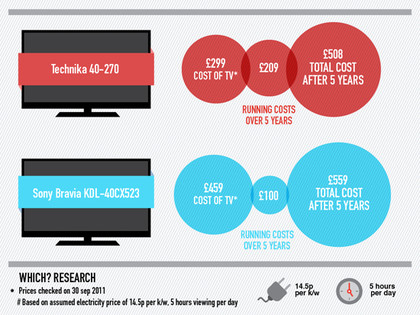New tests conducted by market research magazine Which? on different types of televisions available to customers seem to suggest that low-cost supermarket brand televisions consume more power and cost more money on energy bills in comparison to brand-name counterparts, meaning expensive television models may be more financially viable to consumers in the long run.
The two televisions selected in the investigation were the relatively cheap £299 40 inch Technika 40-270 and the more expensive product, the £459 40-inch Sony Bravia KDL-40CX523.
Energy usage tests on both televisions by the magazine found that it costs £42 a year to run the cheaper Technika, whilst Sony’s set only cost £25 per year to run. Over a five year period the price of the two televisions, including initial cost and energy usage, came to £508 for Technika, and only slightly more for Sony at £559.

The statistics basically show that after 5 years of usage, the price difference between the two models is around £50, as opposed to the initial difference of £150. In theory if the figures could be applied over a longer period of time it would mean that the Sony television would end up costing users less. That is, if both televisions would either still work or be wanted a decade after purchase.
Which? Conversation editor Patrick Steen said: “Cut-price TVs don’t always add up. Not only do they often fail to offer the best picture quality, they also hold a hidden cost.
“Their poor energy efficiency could leave you paying hundreds of pounds extra over the years.”
Let us know your thoughts on our comments below or via our @Gadget_Helpline Twitter page or Official Facebook group.
